
A Plague Tale: Requiem (XS) - Review
by Lee Mehr , posted on 23 November 2022 / 5,063 ViewsReviewer's Note: This review contains FULL SPOILERS for A Plague Tale: Innocence and MODEST SPOILERS for Requiem. I'll circumvent most important details, but bring up early-game developments and infer a few qualities that are tied to the later main plot. Read at your own risk.
2019 was an impressive year for France-based Asobo Studio, which broke from the support contractor routine to create a successful new IP. The developer's tale is a classic one of punching above its respective weight class: a middle-market game developed on a custom engine that wasn't visually far behind other pricier titles. Fast forward to now, Asobo's sequel sheds that younger innocence by becoming a big-budget production. With that, two distinct identities subsequently crop up: a ticked checklist of previous fan expectations and structural similarities to The Last of Us Part II. While impressive in its greater ambition and scope, Requiem’s still stuck with some aggressive fleas.
The year is 1349 AD. Several months have passed since Amicia de Rune, her little brother Hugo, and the rest of their assorted gang faced down a radical sect of The Inquisition. While the Hundred Years' War and The Black Plague are still in the background, their troubles have temporarily subsided. After a dangerous confrontation, Hugo's Macula disease, an affliction that enables him to control rats, flares up once again, demanding the De Runes flee to Provence for aid from a revered organization of alchemists known as 'The Order.'
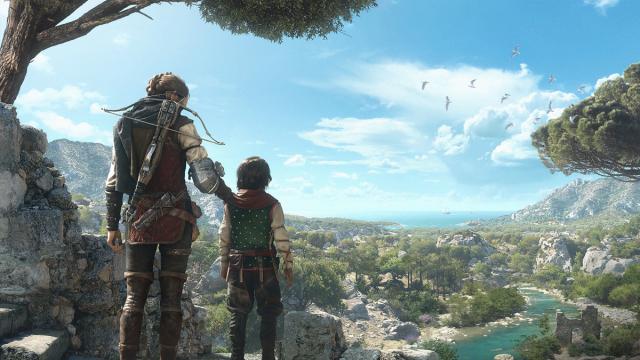
Similar to the original, the crew (Amicia, Hugo, mother Beatrice, and alchemist apprentice Lucas) have acclimatized to their calmer situation before everything goes to hell. The mellow start across a beautiful countryside re-introduces those familiar elements of stealth, Amicia's sling-shotting skills, and so on. But the key difference is it feeling more like a soft prologue instead of the original's firm Chapter One: the enemy's introduction occurs by happenstance and the setup/payoff feels more artificial.
Once past that hurdle, Requiem takes its time to introduce a town and its inhabitants. Instead of the funneled alleyways and vacant farmlands of before, Asobo is intent on temporarily putting cement in your shoes, moving you through lively clusters of people, and occasionally engaging in light talk to find a mission-critical person. Beyond pacing, this gradual buildup is meant to contrast once-bustling areas before and after they've been ravaged by the plague. Here, a mischief of rats is more like a monsoon; within moments, enough of those critters can cause a rapid earthquake, engulf entire brick buildings, and rapaciously devour an entire township – with ample room for desert.
Requiem's main focus comes back to this reality. Amicia and Hugo's bond had been forged in the first title: an ignorant little brother and a recalcitrant older sister go through intense hardship to become true family. Now, Hugo is fully aware of his dangerous abilities and understands the necessity to find a cure; conversely, while Amicia is obsessively devoted to him, her internalized frustration and irascible aggression towards others show just how damaging past events have been to her psyche. Analogous to Part II's Ellie, that question of how far one's willing to go in sacrificing yourself and others for an ultimate goal is thoroughly explored and feels honestly answered by the end.
My hang-up of the prologue's artificiality for emotional resonance sneaks into certain junctions of the main storyline as well. My overarching complaint would be this: I could imagine a better version of these events. Beyond some mental hurdles for the player to get over, like Amicia and Hugo betting all their chips on a recurring dream (which isn't far-fetched within this context), certain scenarios aren't properly built up. Even though Innocence had a similar flaw, it wasn't to the point where I was Monday-morning quarterbacking; here, qualities like a throwaway secondary villain or quaint conveniences didn't gel as often as the intense orchestral score thought they did.
Another example of artifice stems from Requiem's most crucial location. Innocence focused its stages within real areas – Aquitaine, Guyenne, etc. – which felt heavier by tying dark fantasy with historical fiction. The enemy's fangs sunk deeper because of the palpable wretchedness of the actual Inquisition too. Simple, yet effective villainy. While there's still tangible world-building within Requiem's fictional location and great characterization for its key players, there's not as strong a connection to the townspeople's obscure Pagan worship, nor the various enemy groups that just wear different colors. Its heightened adventure-serial sensibilities slightly dampen that special trait from before.
Part of why I'm more critical of Requiem's storytelling admittedly stems back to wanting a different direction, versus an “objective” evaluation. Even though it has a potent emotional core, the way the pieces connect sometimes don't feel as rich as they should. This is also compounded by some incredibly sluggish pacing occupying portions of the middle and end too. Instead of Innocence's well-measured structure of saturnine darkness and uplifting hope, it’s a sequel that tips the scale too far towards the former; that said, it never strains these negatives past a breaking point either. The creative avenues it explores with its duo, the roster of effective side characters, and so on, are still enough to make me excitedly turn the next page.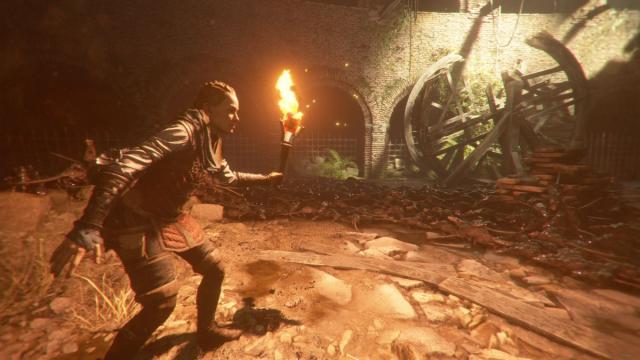
Setting aside the choppier writing waters, Requiem's presentation is a more consistent positive. While the majority of the cast do a commendable job, Charlotte McBurney's Amicia once again steals the show. Even when the writing and Oliver Deriviere tend to pinball across various emotional highs, she does a commendable job of depicting the incredible burden on Amicia's shoulders from beginning to end. It's just a shame that all the credit towards its focused cinematic direction and professional cast is dampened by mismatched lip syncing and occasionally flat faces.
Whatever shortcomings Asobo has with close-ups is nowhere to be found in Requiem's open areas. The beginning's expansive southeastern French fields you explore with Amicia, Hugo, & Lucas already tease a broader amount of player space than the condensed towns of before. These aren't just prettier skyboxes with extra space either; like recent Naughty Dog games, that scale is organically incorporated within the level design. Maneuvering through a town square, fighting guards and eluding rats all the while, feels like a small odyssey with interconnected stealth, combat, puzzle-solving, and potential chase segments. Whether admiring a grand flower festival or the decrepit side of a bustling city, you're thoroughly navigating a space in a way that couldn't be reached with the precursor's lesser resources – not with this level of exquisite detail.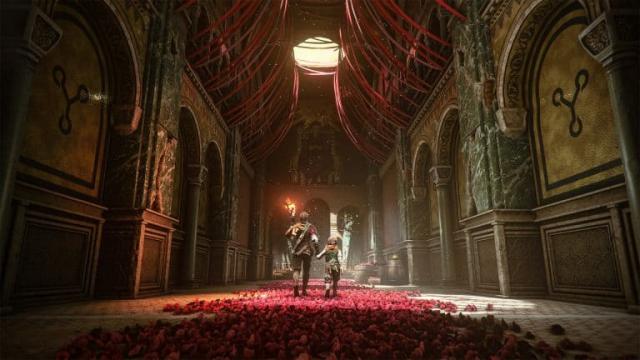
Similarly, Amicia's expanded mechanical vocabulary accommodates these grander arenas. Given how she already transitioned from sling-shotting tyro to head-hunter in the first game, the broader range of previous alchemical tools come in quicker succession: ability to light or extinguish fire, lure rats with a special odor, or the newly-added tar which acts as an enhancement to existing flames or for simply slowing down enemies. Tar may not sound like much until combined with a throwable pot; now you have a jar of oil that's capable of burning multiple soldiers at once or large swathes of tall grass. Beyond adding alchemy to Amicia's slingshot or the pots scattered in the environment, she also has an incredibly satisfying crossbow for good measure.
Even though many of these options are familiar, their uses have increased exponentially thanks to intricate level design. The way Amicia can stealth through tall grass, under carriages, or away from lines of sight feels more dynamic and satisfying as whole. The way you can segue between combat and stealth taps into that apex predator vibe like Part II's Ellie, though it's more restricted due to this era and different design focuses. There's even the insta-kill knife risk/reward idea: use in combat when in a jam or save to break open a secret chest lock.
It's one of those quintessential "more stuff" examples of this year: quality-of-life tweaks that make combat more satisfying, expanded methods of sleuthing or combatting foes, and other supplementary concepts mixed in with the foundation. Given the surprisingly longer runtime (roughly 18 hours for me), it's quite impressive how many one-off wrinkles are utilized against both human and rat foes – oftentimes when both are mixed together. The same applies to its decent mix of puzzles too. Sure, it relies on the "slingshot the weak chain link" hallmark too often, but many others felt different enough either mechanically or due to the specific scenario. Moreso than simply having more things, all of these elements feel better-composed too.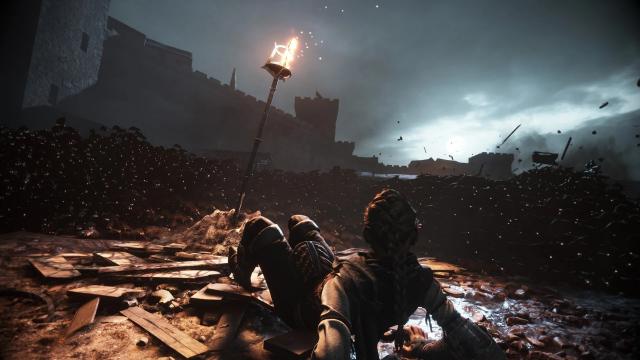
That doesn't mean it’s squeaky clean of previous hang-ups though. Similar to story direction, part of me thought Requiem's design would encourage more freeform player interaction. One illustration would be the three-tiered strictures of movement, where you're afforded a select option on a whim: forced walky-talky bits, forced walking bits but able to jog, and standard speed. Considering the denser story, Asobo liberally utilizes the first two to excessive degrees. Even going down ladders with rats below requires you to throw bait before getting Asobo's permission slip. That may seem like a minor nitpick, but it reflects a kind of overbearing… design-maternalism, when the player can just learn these lessons through punishment instead. Invisible handrails are endemic to this "cinematic-focused" phylum, but it's often too easy to spot the illusion here.
Beyond that constrained hand-holding, I'd also hoped Requiem would have a stronger stealth system. For one, it's really awkward just how loud Amicia sounds when subduing enemies from behind. Someone will oftentimes be within listening range of her protracted takedown, but they're suspiciously slow to respond and react. It's also strange how nonchalant some guards will act if someone spots you, as though their alert levels are segmented despite being in the same area. It may be tied to difficulty (default normal & immersive UI for first playthrough) or the design wanting to avoid swamping the player, but I think Asobo could've worked around this to make stealth even more mechanically dynamic and grounded at the same time.
While the main formula is familiar for returning players, there are a few new extras as well. For starters, aping from Part II's Seattle Day One segment (take a shot!), one level moves the invisible walls way back for a quasi-open world housing a couple scattered puzzles and treasures. Alongside the traditional upgrade tree, there's also a second RPG-lite skill system: three separate meters (Stealth, Combat, and Alchemy) will slowly fill based on your play style and eventually reach thresholds that grant new stats. To be honest, I found it functionally useless. It runs into a logical impasse, namely that I'm already compelled to tackle a task how I want to already. I'd forgotten about it until accidently scrolling through the in-game menu towards the finale.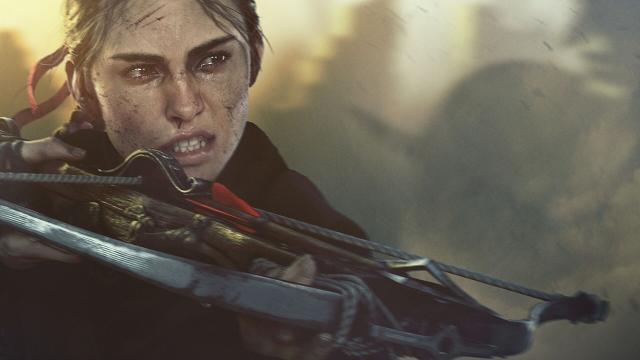
For a sequel, the gameplay foundation still withstands a torrent of specific criticisms. While I hoped Asobo's design ethos would crack the door wider for simulative interactivity alongside its cinematic aspirations, the rollercoaster's variety typically kept my attention. Even with these criticisms, along with other things like unnecessary QTEs, I'm still looking at my calendar for a potential New Game+ run on Hard. Granted, this enthusiasm is conditional on when I finally got to play Requiem too - since I didn't touch it until Version 1.3 released, there were hardly any visual bugs or framerate drops throughout; it wasn't perfect by any means, but the oddities that did happen were negligible. Outside of the slight sting of a locked 30fps (potentially unlocked 40fps on 120hz screens) without a performance visual option, I didn't experience many interruptions in admiring its technical feats.
Asobo had an incredibly lofty goal in mind: craft an enthralling action-adventure title almost double the length of its predecessor. That may not seem like much until also considering the team's jump from middle-market to full-on AAA production alongside it. While I think sacrificing succinctness for expansiveness brought out some of their lesser impulses, in storytelling and gameplay, I also can't help but credit the studio's excitement and earnestness coursing throughout. These issues gnaw away at Requiem's greater potential, but its panoply of technical and creative positives connect consistently enough to thoroughly appreciate Amicia & Hugo's rat-ical journey.
Contractor by trade and writer by hobby, Lee's obnoxious criticisms have found a way to be featured across several gaming sites: N4G, VGChartz, Gaming Nexus, DarkStation, and TechRaptor! He started gaming in the mid-90s and has had the privilege in playing many games across a plethora of platforms. Reader warning: each click given to his articles only helps to inflate his Texas-sized ego. Proceed with caution.
VGChartz Verdict
7
Good
This review is based on a digital copy of A Plague Tale: Requiem for the XS, provided by the publisher.
More Articles
I thought it was a solid game. I'll certainly play Plague Tale 3, but I doubt that I'll play Requiem again. I don't replay many games though, so that doesn't mean a whole lot.
That said, I got really tired of Hugo saying "we should turn back" and similar stuff over and over again. They should cut at least 2/3 of that dialogue out. It was the most annoyed I've been at a video game since the absolutely terrible footstep sound in Xenoblade Chronicles X.
Hugo is a very interesting writing case study on pushing the reasonable limit for precocious children. I totally understand that complaint, but he's also in this special situation where he's grappling with the right choice (in his mind) even when it keeps running up against Amicia's desires. He has a tendency to pester, but I came out neutral on him, given the context.
My point is just that the game is good, and I'd play the next installment if one is made. But, I didn't love it so much that I'm likely to replay it.
In fairness, the only games that I really replay after completing are Halos (other than games that are replayed by default, such as Destiny). So, me saying that I am not likely to replay it is not intended as a slight against the game. It's just saying that I'm not in love with it.
"Outside of the slight sting of a locked 30fps (potentially unlocked 40fps on 120hz screens) without a performance visual option..."
On what platform? It says it's a review for "XS". Xbox Series? Presumably the fidelity is different between Series X and Series S. Though admittedly it's entirely possible the statement above could apply equally to both, just at different resolutions.
Xbox Series X is my go-to for all XS reviews. But the 30fps/conditional 40fps breakdown applies for Series S as well. Like you say, it's just rendered at different resolutions.
Link: https://attackofthefanboy.com/guides/is-a-plague-tale-requiem-locked-to-30fps-on-consoles/
30 fps on this and Gotham knights is absolutely embarrassing
I was surprised by it but in practice there are very few, if any, instances where the gameplay is fast-paced enough for it to feel like a burden.
There also didn’t seem to be many instances of stutter where you can really feel it drag.
I liked this game more than I expected but there were specific instances where I felt it dragged plus the escape sequence immediately following the reveal of the main antagonist felt really irritating.
I did find the visuals to be quite good, particularly the latter stage island of La Cuna as its contrasts itself against its earlier apperance.
If interested to go more in-depth with story, here's the drill: use your initial comment as the [HUGE SPOILER] warning and then reply to it with your observations, critiques, and so on.








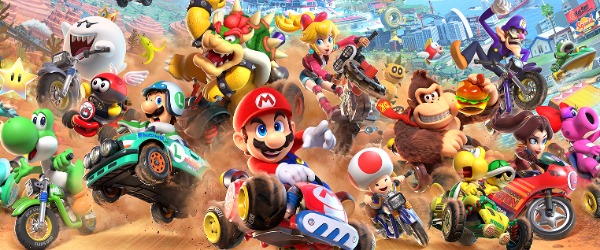


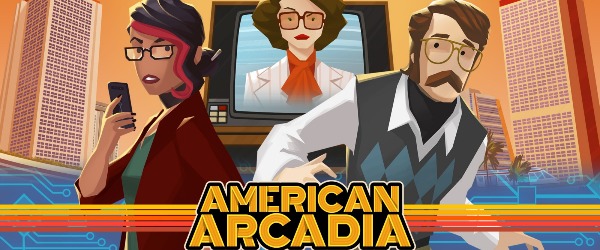












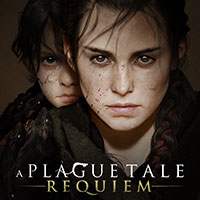



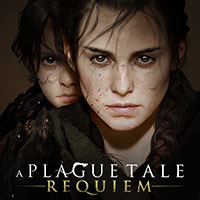

 Essay Pro
Essay Pro